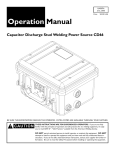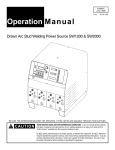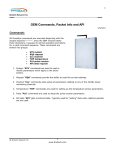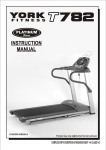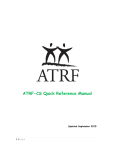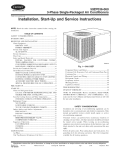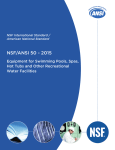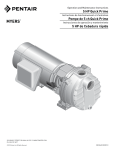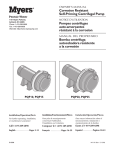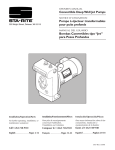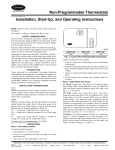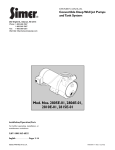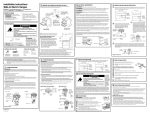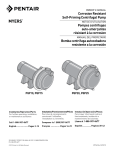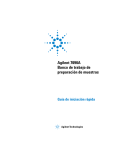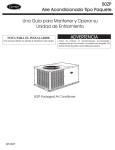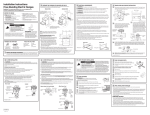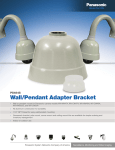Download Operation Manual - Image Industries
Transcript
ILM004B June, 2004 Price $5.50 USD Operation Manual Capacitor Discharge Stud Welding Power Source CD110 BE SURE THIS INFORMATION REACHES THE OPERATOR. EXTRA COPIES ARE AVAILABLE THROUGH YOUR SUPPLIER. CAUTION THESE INSTRUCTIONS ARE FOR EXPERIENCED OPERATORS. If you are not fully familiar with the principles of operation and safe practices for arc welding equipment, we urge you to read AWS SP “Safe Practices” available from the American Welding Society. Do NOT permit untrained persons to install, operate, or maintain this equipment. Do NOT attempt to install or operate this equipment until you have read and fully understand these instructions. If you do not fully understand these instructions, contact your supplier for further information. Be sure to read the Safety Precautions before installing or operating this equipment. Table of Contents SECTION 1: Safety Precautions 3 SECTION 2: Set Up 7 SECTION 3: Normal Operation 10 SECTION 4: Trouble Shooting 14 SECTION 5: System Maintenance 16 SECTION 6: Schematic Diagram 17 SECTION 7: Part List 18 WARRANTY Image warrants that the goods sold will be free from defects in workmanship and material. This warranty is expressly in lieu of other warranties, expressed or implied or for fitness for a particular purpose. The liability shall arise only upon return of the defective goods at Buyer’s expense after notice to Image. The warranty shall be limited to replacement with like goods or, at Image’s option, to refunding the purchase price. Image will not accept receipt of equipment returned unless buyer has previously afforded Image’s personnel a reasonable opportunity to inspect and repair said equipment. Image will warrant components for 1 year and labor for 180 days from date of shipment. Image shall not be liable for any consequential damages including improper set up by buyer. USERS RESPONSIBILITY This equipment will perform in conformity with the description contained in this manual and accompanying labels and/or inserts when installed, maintained and repaired in accordance with the instructions provided. This equipment must be checked periodically. Defective equipment should not be used. Parts that are broken, missing, worn, distorted or contaminated should be replaced immediately. Should such repair or replacement become necessary, the manufacturer recommends that a telephone or written request for service advice be made to the Authorized Distributer from whom purchased. This equipment or any of it’s parts should not be altered without the prior written approval of the manufacturer. The user of this equipment shall have the sole responsibility for any malfunction which results from improper use, faulty maintenance, damage, improper repair or alteration by anyone other than the manufacturer or a service facility designated by the manufacturer. 2 Section 1 Table o Safety Precautions WARNING: These Safety Precautions are for your protection. They summarize precautionary information from the references listed in the Additional Safety Information section. Before performing any installation or operating procedures, be sure to read and follow the safety precautions listed below as well as all other manuals, material safety data sheets, labels, etc. Failure to observe Safety Precautions can result in injury or death. PROTECT YOURSELF AND OTHERS Some welding, cutting, and gouging processes are noisy and require ear protection. The arc, like the sun, emits ultraviolet (UV) and other radiation and can injure skin and eyes. Hot metal can cause burns. Training in the proper use of the processes and equipment is essential to prevent accidents. Therefore: 1) 2) 3) 4) 5) 6) Always wear safety glasses with side shields in any work area, even if welding helmets, face shields and goggles are also required. Use a face shield fitted with the correct filter. Cover sparks and rays of the arc when operating or observing operations. Warn bystanders not to watch the arc and not to expose themselves to the rays of the electric-arc or hot metal. Wear flameproof gauntlet type gloves, heavy long-sleeve shirt, cuffless trousers, high topped shoes, and a welding helmet or cap for hair protection, to protect against arc rays and hot sparks or hot metal. A flameproof apron may also be desirable as protection against radiated heat and sparks. Hot sparks or metal can lodge in rolled up sleeves, trousers cuffs or pockets. Sleeves and collars should be kept buttoned, and open pockets eliminated from the front of clothing. Protect other personnel from arc rays and hot sparks with suitable nonflammable partitions or curtains. Use goggles over safety glasses when chipping slag or grinding. Chipped slag may be hot and can fly far. Bystanders should also wear goggles over safety glasses. FIRES AND EXPLOSIONS Heat from flames and arcs can start fires. Hot slag or sparks can also cause fires and explosions. Therefore: 1) 2) 3) 4) 5) 6) 7) Remove all combustible materials well away from the work area or cover the materials with a protective nonflammable covering. Combustible materials include wood, cloth, sawdust, liquid and gas fuels, solvents, paints and coatings, paper, etc. Hot sparks or hot metal can fall through cracks or crevices in floors or wall openings and cause a hidden smoldering fire or fires on the floor below. Make certain that such openings are protected from hot sparks and metal. Do not weld, cut, or perform other hot work until the work piece has been completely cleaned so that there are no substances on the work piece which might produce flammable or toxic vapors. Do not do hot work on closed containers. They may explode. Have appropriate fire extinguishing equipment handy for instant use, such as a garden hose, water pail, sand bucket or portable fire extinguisher. Be sure you are trained for proper use. Do not use equipment beyond its ratings. For example, overloaded welding cable can overheat and create a fire hazard. After completing operations, inspect the work area to make certain there are no hot sparks or hot metal which could cause a later fire. Use fire watchers when necessary. For additional information, refer to NFPA Standard 51B, “Fire Prevention in Use of Cutting and Welding Processes,” available from the National Fire Protection Association, Batterymarch Park, Quincy, MA 02269 3 ELECTRICAL SHOCK Contact with live electrical parts and ground can cause severe injury or death. DO NOT use welding current in damp areas, if movement is confined, or if there is danger of falling. 1) 2) 3) 4) 5) 6) 7) 8) 9) Be sure the power source frame (chassis) is connected to the ground system of the input power. Connect the work piece to a good electrical ground. Connect the work cable to the work piece. A poor or missing connection can expose you or others to a fatal shock. Use well-maintained equipment. Replace worn or damaged cables. Keep everything dry, including clothing, work area, cables, torch/electrode holder and power source. Make sure that all parts of your body are insulated from work and from the ground. Do not stand directly on metal or the earth while working in tight quarters or a damp area; stand on dry boards or an insulating platform and wear rubbersoled shoes. Put on dry, hole-free gloves before turning on the power. Refer to ANSI/ASC Standard Z49.1 (listed on page 6) for specific grounding recommendations. Do not mistake the work lead for a ground cable. ELECTRIC AND MAGNETIC FIELDS Electric and magnetic fields may be dangerous. Electric current flowing through any conductor causes localized Electric and Magnetic Fields (EMF). Welding and cutting current creates EMF around welding cables and welding machines. Therefore: 1) 2) 3) Operators having pacemakers should consult their physician before welding. EMF may interfere with some pacemakers. Exposure to EMF may have other health effects which are unknown. Operators should use the following procedures to minimize exposure to EMF: A) Route the electrode and work cables together. Secure them with tape when possible. B) Never coil the torch or work cable around your body. C) Do not place your body between the torch and work cables. Route cables on the same side of your body. D) Connect the work cable to the work piece as close as possible to the area being welded. E) Keep welding power source and cables as far away from your body as possible. FUMES AND GASES Fumes and gases can cause discomfort or harm, particularly in confined spaces. Do not breathe fumes and gases. Shielding gases can cause asphyxiation. Therefore: 1) 2) 3) 4) Always provide adequate ventilation in the work area by natural or mechanical means. Do not weld, cut, or gouge on materials such as galvanized steel, stainless steel, copper, zinc, lead, beryllium, or cadmium unless positive mechanical ventilation is provided. Do not breathe fumes from these materials. Do not operate near degreasing and spraying operations. The heat or arc rays can react with chlorinated hydrocarbon vapors to form phosgene, a highly toxic gas, and other irritant gasses. If your develop momentary eye, nose, or throat irritation while operating, this is an indication that ventilation is not adequate. Stop work and take necessary steps to improve ventilation in the work areas. Do not continue to operate if physical discomfort persists. Refer to ANSI/ASC Standard Z49.1 (see listing on next page) for specific ventilation recommendations. ELECTRICALLY POWERED EQUIPMENT Faulty or improperly electrified equipment can cause injury or death. Therefore: 1) 2) 3) 4) Always have qualified personnel perform the installation, troubleshooting, and maintenance work. Do not perform any electrical work unless you are qualified to perform such work. Before performing any work inside a power source, disconnect the power source from the incoming electrical power using the disconnect switch at the fuse box before working on the equipment. Install equipment in accordance with the U.S. National Electrical Code, all local codes and the manufacture’s recommendations. Ground the equipment in accordance with the U.S. National Electrical Code and the manufacturer’s recommendations. 4 CYLINDER HANDLING Cylinders, if mishandled, can rupture and violently release gas. Sudden rupture of cylinder, valve, or relief device can injure or kill. Therefore: 1) 2) 3) 4) 5) Use the proper gas for the process and use the proper pressure reducing regulator designed to operate from the compressed gas cylinder. Do not use adaptors. Maintain hoses and fittings in good condition. Always secure cylinders in an upright position by chain or strap to suitable hand trucks, undercarriages, benches, walls, post, or racks. Never secure cylinders to work tables or fixtures where they may become part of an electrical circuit. When not in use, keep cylinder valves closed. Have valve protection cap in place if regulator is not connected. Secure and move cylinders by using suitable hand trucks. Avoid rough handling of cylinders. Locate cylinders away from heat, sparks, and flames. Never strike an arc on a cylinder. For additional information, refer to CGA Standard P-1, “Precautions for Safe Handling of Compressed Gases in Cylinders”, which is available from Compressed Gas Association, 1235 Jefferson Davis Highway, Arlington, VA 22202 HEARING PROTECTION Prolonged Noise from Capacitor Discharge welding applications can damage hearing if levels exceed limits specified by OSHA. Therefore: 1) 2) 3) Use Approved ear plugs or ear muffs if noise level is high. Warn others nearby about noise hazard. For additional information, refer to OSHA Safety Standards 3074. EYE PROTECTION Flying metal can injure eyes. Welding, chipping, wire brushing and grinding can cause sparks and flying metal. As welds cool, they can throw off slag. Therefore: 1) 2) Wear approved safety glasses with side shields even under your welding helmet. Warn others nearby about flying metal hazard. EQUIPMENT MAINTENANCE Faulty or improperly maintained equipment can cause injury or death. Therefore: 1) 2) 3) 4) 5) 6) Always have qualified personnel perform the installation, troubleshooting, and maintenance work. Do not perform any electrical work unless you are qualified to perform such work. Before performing any maintenance work inside a power source, disconnect the power source from the incoming electrical power. Maintain cables, grounding wire, connections, power cord, and power supply in safe working order. Do not operate any equipment in faulty condition. Do not abuse any equipment or accessories. Keep equipment away from: - heat sources such as furnaces - wet conditions such as water puddles and inclement weather - oil or grease - corrosive atmospheres. Keep all safety devices and cabinet covers in position and in good repair. Use equipment only for its intended purpose. Do not modify it in any manner. 5 MOVING PARTS CAN CAUSE INJURY Electric fan can start at any time without warning and cause severe injury, therefore: 1) 2) 3) 4) 5) Always disconnect electrical power prior to service to prevent the fan from starting unexpectedly. Keep all doors, panels, covers, and guards closed and securely in place. Have only qualified people remove guards or covers for maintenance and troubleshooting as necessary. Keep hands, hair, loose clothing, and tools away from moving parts. Reinstall panels or guards and close doors when servicing is finished and before reenergizing welder. ADDITIONAL SAFETY INFORMATION For more information on safe practices for electric arc welding refer to the following publications: The following publications, which are available form the American Welding Society, 550 N.W. LeJuene Road, Miami, FL 33126, are recommended to you: 1) ANSI/ASC Z49.1 - “Safety in Welding and Cutting” 2) AWS C5.1 - “Recommended Practices for Plasma Arc Welding” 3) AWS C5.6 - “Recommended Practices for Gas Metal Arc Welding” 4) AWS SP - “Safe Practices” - Reprint, Welding Handbook. 5) ANSI/AWS F4.1, “Recommended Safe Practices for Welding and Cutting of Containers That Have Held Hazardous Substances.” This symbol appearing throughout this manual means ATTENTION! BE ALERT! Your safety is involved. The following definitions apply to DANGER, WARNING, CAUTION found throughout this manual. DANGER Used to call attention to immediate hazards which, if not avoided, will result in immediate, serious personal injury or loss of life. WARNING Used to call attention to potential hazards which could result in personal injury or lost of life. CAUTION Used to call attention to hazards which could result in minor personal injury. 6 Section 2 Installation & Set Up LOCATION The power supply should be located: • On a flat, level surfaces with adaquate air circulation • Near the work area to limit welding cable length (shorter lengths are preferred). Avoid looping the weld cables • In a dry area away from moisture. • To protect it from grinding dust and other contaminates. • To provide min. 6” clearance on all sides for cooling. POWER REQUIREMENTS Fusing / Cable Recommendations Input Voltage Frequency Fusing 110 V 50/60Hz 15A 220 V 50/60Hz 10A WARNING WARNING: Do not defeat the incoming power cable ground on the power supply. Extension Cord specifications for incoming power: If an extension cable is required (one is not recommended) use the following guidelines Up to 25 ft. (8 meters) use a minimum of 16-3 wire extension cable 30 ft. (10 meters) use a minimum of 14-3 wire extension cable 50 ft. (15 meters) use a minimum of 12-3 wire extension cable SETTING JUMPER LINKS This power supply ships pre-wired as 110V. If you plan on using 110V no changes are required. The unit can be configured to operate on 220V AC . If you would like to wire your unit to operate on 220V the jumper link arrangement (and the power cord plug) must be changed. NOTE: Charge time will not vary between 110 and 220V. DANGER WARNING. Always be careful when working inside a capacitor storage unit. Always disconnect the incoming power line when working inside of electrical equipment. Even though the power switch is off and the power cable is disconnected, there can still be voltages inside the unit. Incorrect connection of the voltage select jumpers can damage the welding power supply. If you are not comfortable changing the jumper links seek help from your distributor or a trained electrician. Remove the power supply lid by unscrewing eight (8) #10 hex head screws (5/16 wrench or nut runner). The main transformer has configurable jumper links. These are located directly on the main transformer on the top side of the transformer nearest the rear of the unit. There are two jumper wires connected to the transformer. 7 Section 2 Installation & Set Up For a 110V configuration the jumpers connect terminals H1 and H3 and H2 and H4. Figure 1 110 V 110 V H4 H3 H2 H1 For a 220V configuration only one jumper is used between terminals H2 and H3. Figure 2 220 V H4 H3 H2 H1 If connecting as a 220V unit, be sure and place the extra jumper in a safe place. You will need it to reconnect the unit to 110V.Replace the cover and reinstall the 8 #10 hex head screws. WARNING DO NOT OPERATE THE POWER SUPPLY WITHOUT THE COVER SECURELY IN PLACE. 8 Section 2 Installation & Set Up Guns There are typically two cables on your welding tool: a weld cable and a control cable. Dot Weld Cable The weld (gun) cable has a camlok style connector. Line up the flat on the weld cable connector with the small dot on the top side of the panel receptacle (typically the weld cable goes into the black or negative receptacle). Push the weld cable connector straight in as far as it will go [Step 1]. Hand turn clockwise to be tight [Step 2]. See Figure 3 Ground The ground cable is connected in the same fashion as the welding tool weld cable. The ground cable typically is inserted into the red (or positive) receptacle. Flat 2 1 Figure 3 Control Cable There is a key in the end of the control cable connector. Align the key in the cable connector with the key way in the front panel control cable receptacle. Push the cable connector into the front panel receptacle [Step 1]. When the two are seated turn the screw ring on the cable connector clockwise [Step 2]. This will lock the two together. See Figure 4. The screw ring does Key not need to be overly tight. Cable Connections Straight Polarity: In straight polarity the weld tool (gun) is 1 connected to the black receptacle labeled gun (this is electrode negative). The ground lead is connected to the red receptacle (often ground). This cable arrangement is the preferred Figure 4 arrangement for welding ferrous metals with either the gap or contact processes. 2 Key way Reverse Polarity: Reverse polarity reverses the weld tool and ground connections. The weld tool connects to the red receptacle labeled ground (this is electrode positive) and the ground cable connects to the black receptacle (labeled gun). This cable arrangement is preferred for welding materials such as aluminum, brass or galvanized with either the gap or contact processes. Layout: The cables must be laid out straight. If the cables are coiled the amount of energy available for weld will be reduced. This will result in poor quality welds. This is true for both the gun weld cable and the ground cable when using either the gap or contact processes. 9 Section 3 Normal Operation Voltage Adjustment Knob Voltage Display (Amber) Lights when there is a good weld path (Red) Lights when gun trigger is pulled Capacitance Adjustment Knob (Green) Lights when welder is ready to weld DISPLAY FUNCTIONS The main Weld Voltage Display shows the voltage that will be used for welding. There are 3 indicator lights. Trigger (Red) This indicator lights when the trigger is pulled. This shows there is a good connection through the gun trigger switch and cables. Contact (Amber) This indicator lights when the unit detects contact with the work. This means there is a good welding path. Ready (Green) This indicator lights when the unit is ready to weld. If the operator decreases the weld voltage, this light will go out for a moment as the proper voltage is reached. This light can also flash out error codes if certain error conditions occur (see troubleshooting for specific error conditions). ROTARY KNOBS Voltage Control Knob The upper rotary knob controls the weld voltage. Turning the knob clockwise increases the weld voltage up to about 190V, turning the knob counter clockwise will decrease the weld voltage down to about 40V. The power supply will take a moment to achieve the desired setting. Small changes make it easier to hit a target voltage level. 10 Section 3 Normal Operation Capacitance Select Knob The lower rotary knob has 3 positions. The operator can select from 3 different capacitance levels. Low: 66,000uF Medium: 88,000uF High: 110,000uF These different capacitance levels allow the power supply to be fine tuned to match the exact welding application for the highest quality, most repeatable results. POWER UP Before power up, make sure all cables are properly connected. It is also a good practice to turn the voltage control knob to the minimum voltage (all the way counter clockwise). Press the power switch (to the right or towards the 1), located on the lower left side of the control panel. On power up the power supply initiates a self test. This test lasts approximately 2 seconds. The power supply will then charge the level of capacitance set by the capacitance select knob to the voltage level set by the voltage select knob. When charging is complete (3 seconds maximum) the ready light will turn on. Note: If the trigger is held or the weld gun is in contact with the work, charging will be disabled until the trigger is released and/or the weld gun is not in contact with the work. WELDING Stud Gun Settings Refer to Stud Gun Manual Welding Sequence Position the gun against the work. Press down on the stud gun to make sure the spark shield or tripod legs sits firmly against the work. While holding the gun in position, pull the trigger. The weld will initiate and complete. There is a loud bang (hearing protection is recommended) associated with the weld process. This completes a weld sequence. Note: Contact must be made BEFORE the trigger is pressed, otherwise welding will not occur. Post Weld Sequence After the weld is complete, but before the gun is pulled off the work, the unit will charge up to about 20V. When the gun is pulled off the work (and the trigger is released) it will fully charge to the set point. If the operator pulls the gun off the work immediately (and releases the trigger) the unit will charge to the set point. Pull the gun off of the stud. SET UP Base Metal Preparation As with most welding, clean weld studs and clean base metal will provide the best results. Typical weld penetration is .002 to .004 inches (.05 to .1 mm). Mill scale may easily be this thick. When welding to steel with mill scale, the scale must be removed first to achieve quality weld results. 11 Section 3 Normal Operation A common CD welding mistake is to use a centerpunch mark for location. The ignition tip locates nicely in the centerpunch mark, but it effectively shortens the tip length. Since the tip is sitting in a depression, the distance from the workpiece to the face of the weld stud is shorter. Usually, this results in bad welds. Aluminum can quickly form a layer of oxide. Oxide is non-conductive (not good for welding) and is tough. If welding onto aluminum is causing problems, it is often best to remove the oxide layer. This can be accomplished via abrasives. A stainless steel brush works well. Recommended Power Supply Capacitance and Voltage Settings Contact Gun Stud Size 12 ga 10 ga #4 #6 #8 #10 1/4 5/16 3/8 6mm 8mm Mild Steel Capacitance Plunge Low 1/8 Low 1/8 Low 1/8 Low 1/8 Med 1/8 Med 1/8 Med 1/8 Hi 3/16 Hi 1/4 Med 1/8 Hi 3/16 Spring Low Low Low Low Low Low Low Med Hi Low Med Voltage 60 90 65 75 85 95 125 140 170 125 140 Stainless Steel Capacitance Plunge Spring Voltage Aluminum Capacitance Plunge Spring Voltage Low Low Med Med Med Hi 1/8 1/8 1/8 1/8 1/8 3/16 Med Med Med Med Med Med 70 75 85 95 130 150 Low Med Med Med Med 1/8 1/8 1/8 1/8 1/4 Hi Hi Hi Hi Hi 75 80 90 105 150 Med Hi 1/8 3/16 Med Med 130 150 Med 1/4 Hi 150 Acceptable Material Combinations Typical Combinations of Base Metal and Stud Metal for Capacitor Discharge Stud Welding Base Metal Low carbon steel, AISI 1006 to 1022 Stud Metal Low carbon steel, AISI 1006 to 1010, stainless steel, series 300*, copper alloy 260 and 268 (brass) Stainless steel, series 300* and 400 Low carbon steel, AISI 1006 to 1010, stainless steel, series 300* Aluminum alloys, 1100, 3000 series, 5000 Aluminum alloy 1100, 5086, 6063 series, 6061 and 6063 ETP copper, lead free brass, and rolled Low carbon steel, AISI 1006 to 1010, stainless copper steel, series 300*, copper alloys 260 and 268 (brass) Zinc alloys (die cast) Aluminum alloys 1100 and 5086 *Except for the free-machining Type 303 stainless steel. 12 Section 3 Normal Operation Weld Quality Visual Inspection Too Hot Excessive weld flash and weld spatter. This weld may break. Correct Normal weld flash. No significant weld spatter. This will be a good, strong weld. Too Cold No visible weld flash. This weld will break. Reduce Voltage, Increase Spring Pressure, or Reduce Capacitance No Adjustments Required IncreaseVoltage, Reduce Spring Pressure, or Increase Capacitance. Also could be caused by a short tip or a center punch mark CONTACT CAPACITOR DISCHARGE PROCESS The gun begins to drive the stud into the base metal CD Stud is positioned against work on the timing or ignition tip, the gun mechanisms are compressed. Complete fusion The Trigger is pulled, the ignition tip vaporizes and an arc is formed. This arc melts the bottom of the stud and top of the base metal. At the end of travel, the power source is completely discharged and the stud has formed a complete bond with the base material. Note: The tip design/dimensions are very important. The ignition tip controls the arc length and weld duration. If the ignition tip is too short there will not be enough weld time to ensure an adequate weld. 13 Section 6 Trouble Shooting TROUBLE SHOOTING DANGER Problem This guide references components inside the welding power supply. Working inside a capacitor discharge (CD) power supply is inherently dangerous. Do not attempt to service components inside a CD power supply unless you have not been trained in the proper safety and service procedures. If you have questions, please consult your distributor or the factory directly. Possible Cause Poor surface condition. Poor ground connection. Broken or loose cables. Use of center punch or witness marks. Loose collet or chuck. Poor weld. Dirt in gun preventing smooth operation. Cables are coiled. Voltage incorrect for size stud to be welded. Studs or pins are not perpendicular to the work surface. Corrective Action Properly prepare the weld surface. Make sure it is free of contaminants such as dirt and oil. If there is heavy oxide (rust for steel or aluminum oxide for aluminum) it must first be removed. Make sure all cable connections are in good condition and are tightly secured. Make sure all cable connections are in good condition and are tightly secured. Do not use centerpunch/witness marks to locate CD weld studs. They effectively reduce the tip length degrading weld performance. The collet should have a firm hold on the weld stud. If you are able to easily (with no real resistance) pull the stud out of the collet then the collet is worn. Replace Collet. If the inside of the collet looks like there are threads in it then the collet is worn out and should be replaced. Service gun per your gun's service manual. Uncoil weld and ground cables. Check the weld parameter table on page 11 to ensure that you are using the correct voltage for the size stud you are trying to weld. If the operator can not suitably hold the welding tool perpendicular to the work surface, then a template or fixture may be required. Use double grounds, one on each side of the weld zone to balance current flow. Arc blow (all weld material moves or "blows" Move ground connections away from weld zone. to one side). Space ground connections evenly around weld zone. Incorrect plunge setting. Adjust plunge per gun's service manual. Incorrect spring rate. Adjust spring pressure per the gun's service manual. Weld voltage too high. Turn the voltage adjust knob counter-clockwise to decrease weld voltage. Capacitance set too high. Turn the capacitance knob counter-clockwise to charge fewer banks. Weld is too hot. Gap too small when using gap process. If using a gap gun, increase the weld gap per gun's service manual. Plunge too small. Increase the plunge per gun's service manual. Spring pressure to low. Increase the spring pressure per the gun's service manual. Weld voltage too low. Turn the voltage adjust knob clockwise to increase weld voltage. Capacitance set too low. Turn the capacitance knob clockwise to charge more banks. Weld is too cold. Gap too large when using gap process. If using a gap gun, decrease the weld gap per the gun's service manual. Plunge too large. Decrease the pluge per gun's service manual. Spring pressure too high. Decrease the spring pressure per the gun's service manual. Reposition ground clamp to "steer" weld material. Weld material will flow away from Arc blow (all weld material the ground clamp. moves or "blows" to one Ground(s) not positioned properly. side). Use double grounds, one on each side of the weld zone to balance current flow. Broken ground cable or incomplete connection. Broken gun weld cable or incomplete connection. Welder turns on but does Broken control cable. not operate. Shorted trigger switch (trigger LED always on). Faulty trigger switch (trigger LED doesn't light when trigger pulled). Faulty control board. Make sure all cable connections are in good condition and are tightly secured. Make sure all cable connections are in good condition and are tightly secured. Verify continuity on all leads in the control cable (black and white only for contact guns). Verify continuity on the trigger switch. Replace if defective. Verify continuity on the trigger switch. Replace if defective. Replace control board. 14 Section 6 Problem Possible Cause Shorted main charge SCR. Shorted bank charge SCR. Welds too hot regardless of voltage setting. Faulty voltage potentiometer. Faulty control board. Disconnected LED. Green ready LED doesn't Faulty LED. light. Faulty control board. Voltage Adjust knob turned up too high Green ready LED blinks, Faulty voltage potentiometer. welder does not operate. Faulty bank select switch. Faulty control board. Missing or faulty ground. Yellow contact LED Broken sense wire (gap gun). doesn't light when gun is Disconnected LED. placed against work. Faulty LED. Faulty control board. Broken control cable. Red trigger LED doesn't light. Trouble Shooting Corrective Action Replace charge SCR. Replace charge SCR. Verify voltage pot wiper has a resistance of 0-500 ohms. Replace if defective. Replace control board. Ensure LED is seated in holder and holder is pressed firmly onto bezel. Replace LED. Replace control board. Turn the Voltage adjust knob counter-clockwise. Check voltage adjust potentiometer for correct functionality. Verify voltage pot wiper has a resistance of 0-500 ohms. Replace if defective. Verify switch selects one output per position. Replace if defective. Replace control board. Make sure all cable connections are in good condition and are tightly secured. Verify continuity on all leads in the control cable. Ensure LED is seated in holder and holder is pressed firmly onto bezel. Replace LED. Replace control board. Verify continuity on all leads in the control cable (black and white only for contact guns). Control cable not fully connected. Make sure all cable connections are in good condition and are tightly secured. Faulty trigger switch. Disconnected LED. Faulty LED. Faulty control board. Verify continuity on the trigger switch. Replace if defective Ensure LED is seated in holder and holder is pressed firmly onto bezel. Replace LED. Replace control board. Shorted weld capacitor. Circuit fuse or CD110 breaker blows each time Shorted bridge rectifier. unit is powered on. Incorrect primary connections. Shorted transformer. Not plugged in. Breaker blown. Welder does not turn on. Faulty power switch. Faulty control board. Weld SCR shorted. Welder shuts down Faulty power switch. immediately. Faulty control board. Charge SCR shorted or open. Welder shuts down in a Faulty power switch. few seconds. Faulty control board. Welder shuts down after a Charge SCR shorted or open. few minutes. Faulty control board. Weld SCR shorted or open. Breaker blown. Welder shuts down after a Faulty power switch. weld. Incorrect gap gun adjustment. Faulty control board. Use a capacitance meter to test function of each weld capacitor. Visually inspect weld capacitors for obvious signs of damage. Replace any defective weld capacitor. Replace bridge rectifier. Check the jumper links on the transformer. Replace transformer. Plug in unit. Reset breaker. Replace power switch. Replace control board. Replace weld SCR. Replace power switch. Replace control board. Replace charge SCR. Replace power switch. Replace control board. Replace charge SCR. Replace control board. Replace weld SCR. Reset breaker. Replace power switch. Gap process welds must complete within 400ms of trigger pull. Make adjustment per your gun's service manual. Replace control board. 15 Section 7 System Maintenance SYSTEM MAINTENANCE Power Supply This system has been designed to be essentially maintenance free. The only recommended maintenance is to blow out the power supply once a year. Dirt, grinding dust and other contaminates can accumulate over time and they deteriorate the power supply’s cooling performance. If the unit is located in a dirty environment the unit should be blown out more frequently. Welding Tool Typically, most trouble stems from the stud gun. The stud gun should be serviced once every quarter. Monthly service may be required if use is exceptionally heavy. Please refer to the stud gun service manual for maintenance guidelines and instructions. Cables Cables are also a frequent source trouble. Users often drag the power supply around by the cables. This can damage cables. Whenever gun service is performed, the cables should be visually inspected for worn / damaged insulation or fraying wire. If the cables are damaged they should be repaired to prevent any degradation of weld quality. BUILT IN EQUIPMENT SAFETY A fault in the welding power supply can create a potentially dangerous condtion. The microprocessor continually monitors the system for faults and shuts the unit off when one is detected. This is done for operator and equipment safety purposes. The unit can be restarted, but will shut down again as soon as the fault condition is detected. The unit must be repaired. 16 Schematic Diagram Section 8 Wire 1 Wire 2 Wire 3 Wire 4 Wire 5 Wire 6 Wire 7 Wire 8 Wire 9 Wire 10 Wire 11 Wire 42 Wire 13 Wire 15 Wire 17 Wire 18 Wire 19 Wire 20 Wire 21 Wire 22 Wire 23 Wire 24 WIRE-5 WIRE-18 WIRE-22 WIRE-20 WIRE-24 J8 BLACK WHITE BLUE BROWN GUN CONNECTOR 1 WHITE J3 2 BLACK GREEN - READY 1 WHITE J4 2 BLACK YELLOW - CONTACT - 4 D3 BRIDGE + 1 WHITE J5 2 BLACK RED - TRIGGER 2 2 WIRE-41 WIRE-42 2 78 1 Q3 3 910 4 11 2 SW3 N.O. FAN THEMALSWITCH 56 1 J14 WIRE-29 AC1 AC2 WIRE-29 WIRE-15 12 T1 R5 FAN C1 Primary Bank C2 R2 WIRE-21 C3 Q1 C4 Bank #1 D1 WIRE-23 3 R3 C5 Q2 2 R1 Bank #2 1 D2 R4 Q4 SW1 9 8 7 12 11 10 Revision D WIRE-10 1 2 3 C7 C6 WELD- J10 WELD+ J9 BANK SELECT 4 5 6 13 17V 1A 17V 1B 17V 3A 17V 3B L1 Hot VSET Low L2 Hot VSET High 120 VAC Bank Switch Pin13 Breaker Trip Neutral Cap Minus Charge SCR Gate Gun Common (Black) Bridge Plus Coil RTN (Blue) Bank1 SCR Gate Trigger RTN (White) Bank2 SCR Gate Gun Ground Ring (Brown) Wire 26 Wire 27 Wire 28 Wire 29 Wire 30 Discharge Resistor Weld Minus Weld SCR Gate (White) Bank Switch Pin3 Cap Plus Bank Switch Pin 2 12(k) WIRE-9 WIRE-7 1 SW2 N.O. SHUTDOWN THEMALSWITCH WIRE-17 J13 17 Wire 32 Wire 33 Wire 34 Wire 35 Wire 36 Wire 37 Wire 38 Wire 39 Wire 40 22(k) WIRE-12 15 14 13 12 11 10 9 8 7 6 5 4 3 2 1 1 3 VSET Sig Ready LED White Ready LED Black Trigger LED White Trigger LED Black Contact LED White Contact LED Black 17V 2A 17V 2B 11 12(n) SW4 12 21 WIRE-42 WIRE-11 15 14 13 12 11 10 9 8 7 6 5 4 3 2 1 J6 WIRE-13 1 2 3 4 5 6 7 8 9 10 11 12 13 14 15 16 17 18 19 20 21 22 23 24 25 26 27 28 29 30 31 32 33 34 35 36 37 38 39 40 CONTROL BOARD J1 WIRE-43 WIRE-44 2 J2 WIRE-19 J11 J12 WIRE-49 WIRE-47 WIRE-48 WIRE-46 J7 PLUG AC MALE 1 3 WIRE-13 WIRE-27 WIRE-26 Section 9 Parts List 1 2 11 12 7 4 8 10 9 5 7 6 13 3 14 19 17 15 to #24 16 18 20 6 22 23 26 to #34 27 24 28 25 29 31 30 32 33 35 Red Yellow Green 34 36 37 42 38 39 41 40 18 Section 9 Item 01 02 03 04 05 06 07 08 09 10 11 12 13 14 15 16 17 18 19 20 22 23 24 25 26 27 Description Handle Handle Screw Sheet Metal Cover Cover Screws Transformer Transformer Mounting Nut Transformer Mounting Screw Transformer Voltage Select Jumper Diode Insulator Bank Select Diode SCR SCR Insulator Kit #10-32 X 1/2 Hex Screw #10 Bellville Washer Isolator Shoulder Washer #10-32 x 3/8 Hex Screw Discharge Resistor Resistor Bracket Positive Buss Bar Negative Buss Bar #1 Cooling Fan Fan Mounting Screw Bridge Rectifier Control Printed Circuit Board Capacitor Retention Block Negative Buss Bar #2 Charge Resistor Charge Resistor Mounting Screw Weld Capacitor Capacitor Retention Strap Card Guide Positive Jumper Coupling Nut Connector Stud Fan Guard Parts List Part Number PKM111 PPC31-62ZP PKS240 HSC19-37ZP PKE501 NUC25-50 PPC25-50ZP PKH002 EI001 ED5004 ESR5006SM EI002 HBC19F-50ZP WBC19 WSN20-40-06X26-50 HBC19F-37ZP ER100W-100 ERB-50 PKE2210 PKE2220 PKE900 BHC16-125 EBR03504Q PKP101 PKK300 PKE2230 ER50W-10A PPC11-37ZP EC200-22KE CTN19-14.5 PKK101 CW2SR-.65 NCC19-75ZP TRC19-5 PKM900 19 Item Description 28 Knob 29 Face Plate Decal 30 Voltage Meter Power Cord 31 Cord Grip Meter Bezel 32 Bezel Push Nut 33 Capacitance Selector Switch 34 Weld SCR Red LED Lens Yellow LED Lens Green LED Lens 35 Red LED Yellow LED Green LED 36 Power Switch/Breaker 37 Red Ground (+ pos) Cable Connector 38 Black Weld Cable (- neg) Connector 39 Control Cable Connector 40 Chassis 41 Voltage Select Potentioneter 42 Weld SCR Mounting Bracket Part Number PAM110 PKD225 PKE101 PKE9000 PKM50 PKM101 PKM102 PKE2 PKE4 PKM81 PKM82 PKM83 ELED-R5 ELED-A5 ELED-G5 PKE101 CCL1/0RFR CCL1/0RFB CSS4MR PKC225 ERV25-500 PKE2120 Items Not Shown 43 Wiring Harness 44 Filter Network Weld Output 45 Weld Capacitor Tie Down Strap PKH001 PAE801 CTN19-14.5 Please visit us on the web at www.imageindustries.com




















